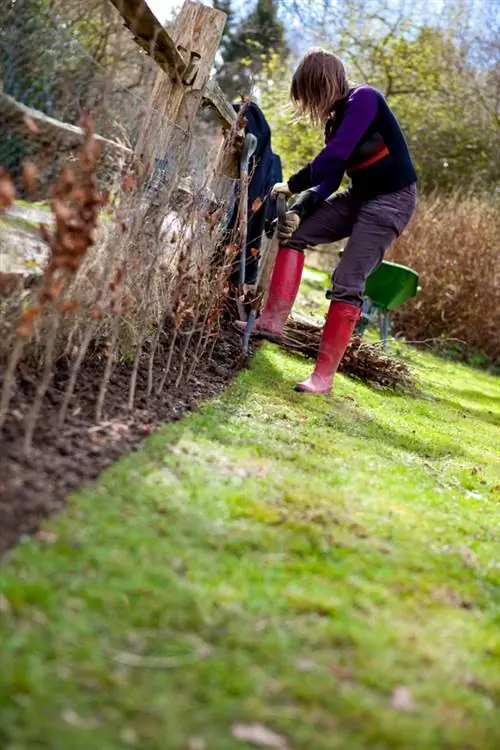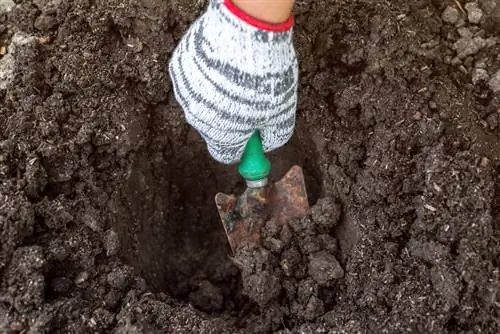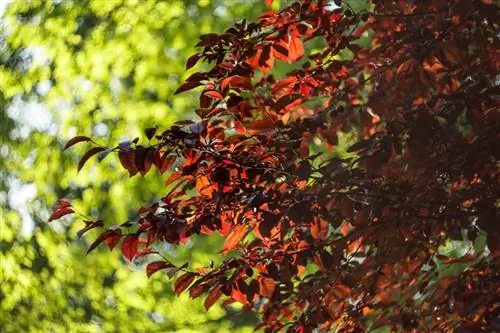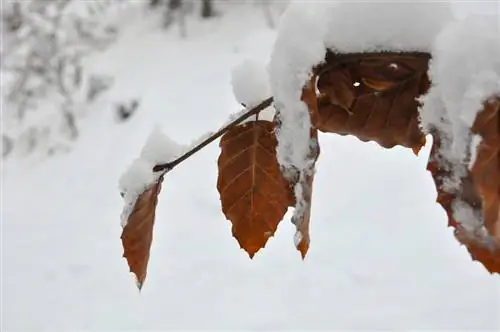- Author admin [email protected].
- Public 2023-12-16 16:46.
- Last modified 2025-06-01 06:02.
Read the profile about the beech hedge here for information on growth per year. Many planting and care tips from the correct planting distance to perfect pruning.
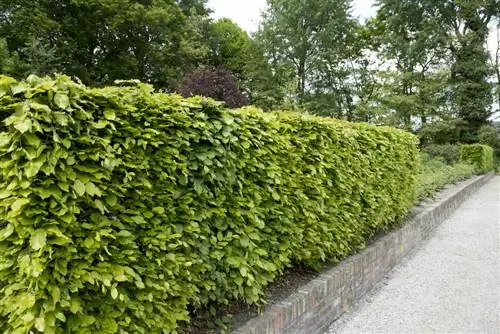
How do you grow and care for a beech hedge?
The red beech hedge is an ideal hedge plant that grows 20-70 cm per year and is suitable as a wind and privacy screen thanks to its dense branches and deep green leaves. Regular care such as watering, fertilizing and cutting is important for a he althy and attractive hedge.
Profile
- Scientific name: Fagus sylvatica
- Family: Beech family (Fagaceae)
- Growth type: deciduous tree or shrub
- Occurrence: Europe
- Growth: 20-70 cm per year
- Growth habit: bushy
- Leaf: deciduous, egg-shaped
- Flower: simple, inconspicuous
- Flowering time: March/April to May/June
- Fruit: beechnuts
- Roots: Heartroots
- Use: hedge plants
Growth per year
Common beeches are the ideal hedge plants for wind and privacy protection within a short period of time. When young, the deciduous shrubs grow rapidly. Older trees take things more slowly. This annual increase can be expected if the general conditions are right:
- Growth per year after planting: 40 cm to 70 cm
- Growth per year after 30 to 50 years: 20 cm to 40 cm
Fast growth of beech hedges is just one of their many advantages. The following video explains why native trees are always a good decision as a hedge in a natural garden:
Video: Native hedge plants - treasure trove for birds, insects
Leaf
The name common beech does not refer to the color of the leaves, but to the reddish wood. For cultivation as hedge plants with red leaves, you can find the copper beech variety (Fagus sylvatica f. purpurea) in nurseries or garden centers. The following characteristics characterize the red beech leaf of the original species:
- Color: Fresh green shoots, shiny dark green above in summer, light green below
- Special feature: silky hairy young leaves
- Autumn coloring: reddish-yellow to red-orange
- Shape: stalked, ovoid, pointed
- Size: 7 cm to 10 cm long, 5 cm wide
After the autumn color changes, the leaves dry up, turn brown-red and remain on the branches until spring. In this way, a beech hedge provides year-round privacy.
Flowering time
The European beech thrives as a monoecious tree. Male and female flowers can therefore be admired in a crown.
- Flowering time: March/April to May/June at the same time as the leaves emerge
- Worth knowing: first flowering period at the earliest between the ages of 30 and 50
- Male flowers: green, drooping clusters, 3 cm to 5 cm long
- Female flowers: greenish with pink stigmas, erect
As pruned hedge plants, European beeches generally do not produce beech nuts as fruit.
Roots
The common beech tree develops a system of roots that simultaneously grow diagonally into the depths and laterally in all directions. In cross section, the hemispherical root network is reminiscent of a heart. When planting heartroot trees, it should be noted that lateral roots can potentially lift adjacent paving surfaces. The weak root strands cannot penetrate properly laid supply pipes.
A common beech hedge is also characterized by its pronounced susceptibility to soil accumulation in the root area. Even a layer of mulch of more than 10 centimeters on the tree disc can cause the trees to die.
Excursus
Common beech hornbeam differences
In gardening terms, the term beech hedge refers to the common beech (Fagus sylvactica) or hornbeam (Carpinus betulus). In contrast to the common beech, the hornbeam is a birch tree whose leaves are strongly veined and distinctively sawn. There are no significant differences in terms of cutting tolerance, autumn color and growth per year.
Planting a beech hedge
In this section you will read useful information on the four big W questions surrounding the professional planting of a red beech hedge: When? - Where? - What distance? - How?
Planting time
The quality of the planting material not only determines the price of a beech hedge, but also the planting time. You can get a bare-root Heister with a height of 80 cm to 120 cm at the tree nursery for just 1.50 euros. In return, a limited planting time must be accepted:
- Planting bare-rooted trees: September to March
- Planting container goods: all year round, but not in frost or dry periods
Location
A beech hedge thrives in almost any location:
- Sun, partial shade or shade
- Normal garden soil
- Preferably in fresh to moist, nutrient-rich soil
Soils with an acidic pH value, waterlogging or sandy-dry soil are not suitable.
Planting spacing
The correct planting distance is one of the key functions for the successful planting of a beech hedge. The following table provides an overview:
| Growth height (bare root product) | Planting distance standard | Number per meter | Planting distance optimal | Number per meter |
|---|---|---|---|---|
| 40 cm to 60 cm | 15 cm to 20 cm | 5 to 6 | 10 cm to 12 cm | 8 to 10 |
| 60 cm to 100 cm | 20 cm to 25 cm | 4 to 5 | 12 cm to 15 cm | 6 to 8 |
| 100 to 150 cm | 25 cm to 35 cm | 3 to 4 | 15 cm to 20 cm | 5 to 7 |
| 150 cm to 220 cm | 35 cm to 50 cm | 2 to 3 | 15 cm to 25 cm | 4 to 6 |
For hedge plants in small containers, you can set the planting distance slightly larger. For example, with a growth height of 60 cm to 80 cm, you can get by with 3 to 4 plants per linear meter.
Planting - Tips & Tricks
A few hours before planting, place the roots or root balls of young beech trees in water. In the meantime, measure the planting trench and mark the route with strings stretched out. This approach is more effective than planting in individual holes. A helping hand is recommended to keep the bushes straight. It's worth taking a look at further tips & tricks:
- Cut the root beard of bare root products back by half and thin it out.
- For container goods, lightly score the root ball.
- Sprinkle a soil activator into the planting trench.
- Enrich the excavation by one third with compost and horn shavings.
- Place trees at the correct planting distance next to the ditch.
- Plant beeches without touching the roots.
- Important: plant at the same depth as before in the nursery (recognizable by soil marks on the shoots).
- Press the soil down well and slurry it in with plenty of water without causing waterlogging.
Saving hunters don't buy Heister or container plants from the nursery, but instead propagate European beeches from cuttings. It's best to cut the cuttings in summer, when beech hedges are already being trimmed. In a semi-shaded propagation bed or in a nursery pot, cultivate the cuttings to a height of 30 cm to 40 cm suitable for planting.
Maintaining the beech hedge
Regular watering, fertilizing and cutting are the mainstays of the care program for a beech hedge. You can read useful tips in the following sections:
Pouring
Drought stress is the most common cause when a beech hedge does not grow. To prevent the newly planted beech hedge from drying out, water it in the first few weeks and months whenever the soil in the root area feels dry. If the trees have become firmly rooted in the ground, the normal rainfall covers the water requirements.
Fertilize
Providing nutrients to a beech hedge is easy. In spring, sprinkle a few handfuls of horn shavings onto the root area. Alternatively, distribute 2 to 3 liters of compost per square meter. As an exception, do not rake in the organic fertilizer to avoid damaging the shallow roots in the topsoil. Instead, water the root slices with a watering can or garden hose.
Cutting
Fast-growing beech trees are completely compatible with pruning. You should cut a young beech hedge twice a year. Then the trees do not become bare at the bottom, but instead branch out densely bushy from the base to the crown. An older beech hedge needs one pruning every year to keep it looking well-groomed. The following overview summarizes everything important for perfect cut care:
- When to cut? End of June/beginning of July, cut young beech hedges again in winter until the end of February.
- How to cut? Cut annual growth back by half.
- What to pay attention to? Move the hedge trimmer from bottom to top and cut the hedge into a trapezoid shape (narrow crown, wide base).
- What is important? Before each pruning, check the hedge for wild animals and cut later if necessary.
Have you given an old beech hedge a rejuvenation cut? Then the time window is open from November to February. Divide the radical pruning into two stages. In the first winter, cut one long side and one side. Next winter, focus on the other side and flank of the hedge.
Diseases and pests
You won't have to complain about diseases on your beech hedge. Lice, especially the beech aphid (Phyllaphis fagi), sometimes cause problems. As a rule, birds make short work of the beasts. In hot, dry summer weather, mass infestations of pests can occur. In this case, spray the beech hedge repeatedly with the proven soap and alcohol solution.
Popular varieties
Color comes into play in a red beech hedge when you combine different varieties from the nursery with the original species:
- Cuplar beech 'Purpurea': deep red shoots, later red-green leaves; requires free root area for optimal growth.
- Dwarf beech 'Asterix': nice for the small beech hedge with a height and width of 100 cm to 125 cm.
- Common beech 'Tricolor': Rarity with black-red, pink-edged leaves and yellow-brown autumn color.
FAQ
Can you plant a beech hedge in summer?
Yes, you can plant a beech hedge in summer. At this time of year, the tree nursery offers pre-grown trees in small containers. Soak the potted root balls in water for a few hours. Lightly score the potted, soaked root balls before planting. To prevent the young beech hedge from drying out after summer planting, water regularly in the early morning or in the evening.
How to cut a beech hedge in winter?
Winter is the best time to trim a beech hedge vigorously. In contrast to summer pruning, the Federal Nature Conservation Act allows radical pruning measures between the beginning of November and the end of February that go beyond this year's growth. The good-natured pruning tolerance of copper beech also allows it to be cut back into old wood in light frost down to -5° Celsius.
Common beech hedge or hornbeam hedge - what’s the difference?
Common beeches (Fagus sylvatica) as hedge plants have shiny green leaves in summer, which dry up after the autumn color but do not fall off. In contrast, hornbeams (Carpinus betulus) belong to the birch family (Betulaceae) and shed their summer-green foliage after a yellow autumn color. Furthermore, a red beech hedge does not tolerate any embankment or intensive tillage in the root area. A hornbeam hedge won't mind if you mulch or rake it vigorously.


